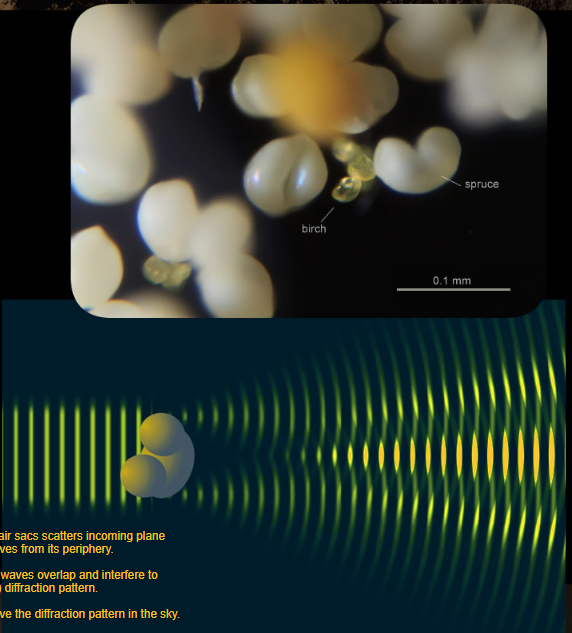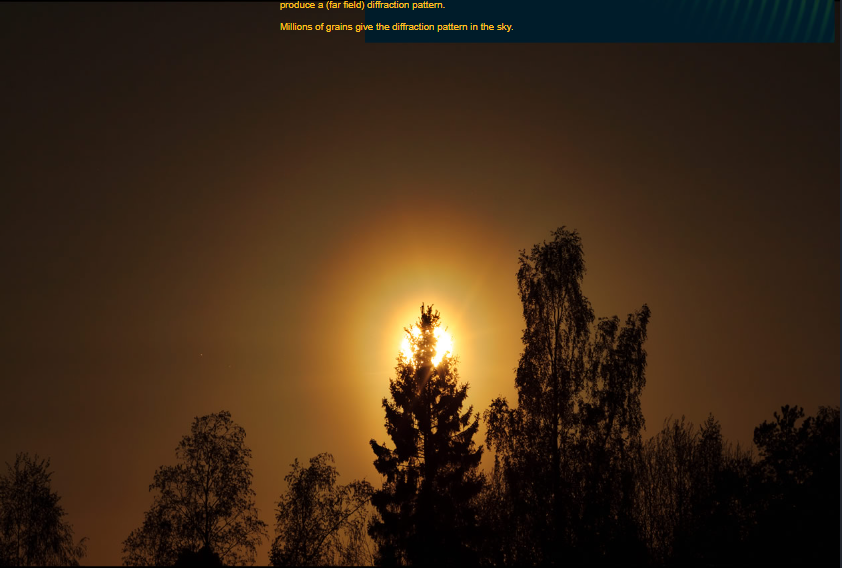OPOD - Pollen Coronae
OPOD - Pollen Coronae: A Fascinating Phenomenon in the Sky
Pollen coronae, a captivating atmospheric optics phenomenon, have been observed in various parts of the world. These coronae, characterized by oval rings, are formed when non-spherical pollen grains scatter sunlight waves and produce diffraction patterns in the sky. While most coronae are circular and generated by small water drops or cloud ice crystals, pollen grains possess unique properties that result in their distinct oval-shaped coronae.
Pollen grains, with their non-spherical shape and air sacs, play a crucial role in creating these mesmerizing coronae. The air sacs, which aid in wind dispersal, inadvertently orient the grains in a specific manner, leading to the formation of oval coronae. Additionally, these grains often exhibit bright spots within the corona, adding to their visual allure.
The size of a pollen corona is directly influenced by the size of the pollen grain itself. Smaller grains tend to produce larger coronal rings, while larger grains generate smaller inner coronae. This size correlation provides a fascinating insight into the relationship between pollen characteristics and the resulting optical phenomena.
To understand how pollen coronae are formed, we must delve into the principles of diffraction. When sunlight waves interact with a pollen grain, they are scattered from its periphery. As these outgoing waves overlap and interfere with each other, a diffraction pattern is produced in the far field. It is this intricate pattern that manifests as a pollen corona when millions of grains collectively contribute to the scattering process.
The exceptional pollen corona images captured by Jari Luomanen in Finland showcase the captivating beauty of this atmospheric phenomenon. Luomanen's photographs reveal two distinct superimposed coronae, created separately by spruce and birch pollen grains. The contrasting oval rings produced by these two types of pollen grains provide a visual spectacle that is both enchanting and scientifically intriguing.
The study of pollen coronae not only enhances our understanding of atmospheric optics but also sheds light on the diverse characteristics of pollen grains. By exploring the relationship between pollen size, shape, and the resulting corona features, researchers can gain valuable insights into the dispersion and behavior of different types of pollen in the atmosphere.
In conclusion, pollen coronae are a remarkable natural phenomenon that arises from the scattering and diffraction of sunlight waves by non-spherical pollen grains. These grains, with their unique properties and air sacs, produce oval coronae that captivate the observer's imagination. The size of the corona is directly influenced by the size of the pollen grain, providing a fascinating correlation between pollen characteristics and optical effects. Through the study of pollen coronae, scientists can deepen their understanding of atmospheric optics and gain valuable insights into the behavior of different types of pollen in the environment.

A Tale of Two Pollens
An unusual pollen corona imaged in Finland by Jari Luomanen (optics images). The oval rings are characteristic of pollen coronae. However, there are too many rings! There are actually two superimposed coronae made separately by spruce and birch pollen grains.
©Jari Luomanen, shown with permission.

A corona – a bright aureole around the sun or moon and surrounded by one or more coloured rings – is generated by diffraction. Most coronae - from small water drops or cloud ice crystals - are circular.
Pollen grains are different, they are non-spherical and a good many have two air sacs to help them carry in the wind. The air sacs quite incidentally orient the grains and these produce oval coronae sometimes with bright spots.
Corona size depends on pollen size – small grains give larger coronae. The small green grains in Jari Luomanen’s sample at right are birch pollen. They produced the larger coronal rings. The much larger white spruce pollen produced the smaller inner corona.
A pollen grain with air sacs scatters incoming plane parallel sunlight waves from its periphery.
Outgoing spherical waves overlap and interfere to produce a (far field) diffraction pattern.
Millions of grains give the diffraction pattern in the sky.

Note: this article has been automatically converted from the old site and may not appear as intended. You can find the original article here.
Reference Atmospheric Optics
If you use any of the definitions, information, or data presented on Atmospheric Optics, please copy the link or reference below to properly credit us as the reference source. Thank you!
-
<a href="https://atoptics.co.uk/blog/opod-pollen-coronae/">OPOD - Pollen Coronae</a>
-
"OPOD - Pollen Coronae". Atmospheric Optics. Accessed on April 25, 2024. https://atoptics.co.uk/blog/opod-pollen-coronae/.
-
"OPOD - Pollen Coronae". Atmospheric Optics, https://atoptics.co.uk/blog/opod-pollen-coronae/. Accessed 25 April, 2024
-
OPOD - Pollen Coronae. Atmospheric Optics. Retrieved from https://atoptics.co.uk/blog/opod-pollen-coronae/.